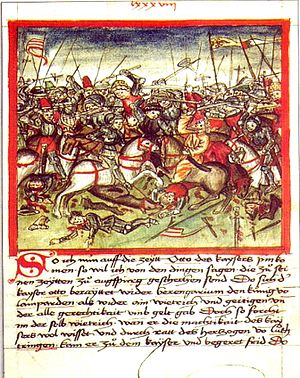The Kingdom of Hungary, a country in Central Europe, came into being in the High Middle Ages, when Stephen I, Grand Prince of the Hungarians, was crowned king in 1000 or 1001. He reinforced central authority and forced his subjects to accept Christianity. Although written sources emphasize the role played by German and Italian knights and clerics in the process, a significant part of the Hungarian vocabulary for agriculture, religion and state was taken from Slavic languages. Civil wars, pagan uprisings and the Holy Roman Emperors' unsuccessful attempts to expand their authority over Hungary jeopardized the new monarchy. Its position stabilized under Ladislaus I (1077–1095) and Coloman (1095–1116). They occupied Croatia and Dalmatia, but both realms reserved their autonomous position. Their successors—especially Béla II (1131–1141), Béla III (1176–1196), Andrew II (1205–1235), and Béla IV (1235–1270)—continued this policy of expansion towards the Balkan Peninsula and the lands to the east of the Carpathian Mountains, transforming their kingdom into one of the major powers of medieval Europe. Rich in uncultivated lands and in silver, gold, and salt deposits, the kingdom became a preferred target of the continuous immigration of mainly German, Italian and French colonists. The colonists were mostly peasants who settled in villages, but also large number of townsfolk arrived as craftsmen and merchants. Their arrival contributed to the development of Esztergom, Székesfehérvár and many other cities and large number of villages in various parts of the Kingdom. Situated at the crossroads of international trade routes, Hungary was affected by several cultural trends. Romanesque, Gothic and Renaissance buildings, and literary works written in Latin prove the predominantly Roman Catholic character of the culture of the Kingdom, but Orthodox, and even non-Christian ethnic minority communities also existed. Latin was the language of legislation, administration and judiciary, but "linguistic pluralism" (János M. Bak) contributed to the survival of a number of tongues, including a great variety of Slavic dialects.The predominance of royal estates initially ensured the sovereign's preeminent position, but the alienation of royal lands gave rise to the emergence of a self-conscious group of lesser landholders. They forced Andrew II to issue his Golden Bull of 1222, "one of first examples of constitutional limits being placed on the powers of a European monarch" (Francis Fukuyama). The kingdom received a major blow from the Mongol invasion of 1241-42. Thereafter Cuman and Jassic groups were settled in the central lowlands and colonists arrived from Moravia, Poland and other nearby countries. The erection of fortresses by landlords, which was promoted by the monarchs after the withdrawal of the Mongols, contributed to the development of semi-autonomous "provinces" dominated by powerful magnates. Some of these magnates even challanged the authority of Andrew III (1290–1301), the last male descendant of the native Árpád dynasty. After his death a period of interregnum interrupted royal power in the early 14th century.




Commenter
0